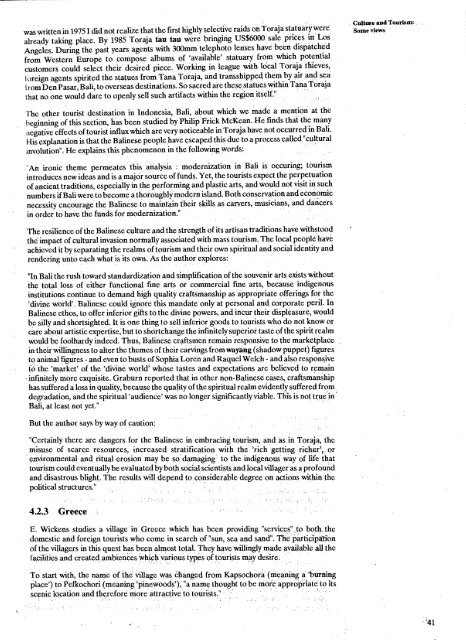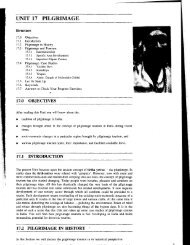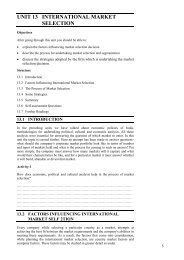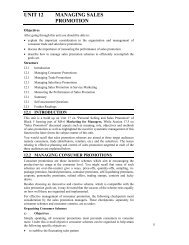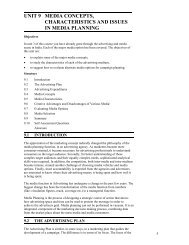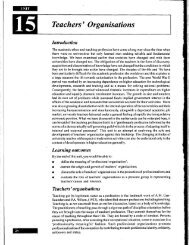UNIT 4 TOURISM AND CULTURE : SOME VIEWS - eGyanKosh
UNIT 4 TOURISM AND CULTURE : SOME VIEWS - eGyanKosh
UNIT 4 TOURISM AND CULTURE : SOME VIEWS - eGyanKosh
You also want an ePaper? Increase the reach of your titles
YUMPU automatically turns print PDFs into web optimized ePapers that Google loves.
was written in 1975 I did not realize that the first highly selective raids on Toraja statuary were<br />
already taking place. By 1985 Toraja tau tau were bringing USS6000 sale prices in Los<br />
hgeles. During the past years agents with MOmm telephoto lenses have been dispatched<br />
from Western Europe to compose albums of 'available' statuary from which potential<br />
customers could select their desired piece. Working in league with local Toraja thieves,<br />
toreign agents spirited the statues from Tana Toraja, and transshipped them by air and sea<br />
tromDen Pasar, Bali, to overseas destinations. So sacred are these statues within Tana Toraja<br />
that no one would dare to openly sell such artifacts within the region itself."<br />
'The other tourist destination in Indonesia, Bali, about which we made a mention at the<br />
beginning of this section, has been studied by Philip Frick McKem. He finds that the many<br />
negative effects of tourist influx which are very noticeable in Toraja have not occurred in Bali.<br />
His explanation is that the Balinese people have escaped this due to a process called "cultural<br />
~nvolution". He explains this phenomenon in the following words:<br />
'An ironic theme permeates this analysis : modernization in Bali is occuring; tourism<br />
introduces new ideas and is a major source of funds. Yet, the tourists expect the perpetuation<br />
of ancient traditions, especially in the performing and plastic arts, and would not visit in such<br />
numbers if Baliwere to become a thoroughly modern island. Both consewatioa and economic<br />
necessity encourage the Balinese to maintain their skills as carvers, musicians, and dancers<br />
in order to have the funds for modernization."<br />
The resilience of the Balinese culture and the strength of its artisan traditions have withstood<br />
the impad of cultural invasion normally associated with mass tourism. The local people havk<br />
achieved it by separating the realms of tourism and their own spiritual and social identity and<br />
rendering unto each what is its own. As the author explores:<br />
"In Bali the rush toward standardization and simplification of the souvenir arts exists without<br />
the total loss of either functional fine arts or commercial fine arts, because indigenous<br />
institutions continue to demand high quality craftsmanship as appropriate offerings for the<br />
'divine world'. Balinese could ignore this mandate only at personal and corporate peril In<br />
Balinese ethos, to offer inferior gifts to the divine powers, and incur their displeasure, would<br />
be silly and shortsighted. It is one thing to sell inferior goods to tourists who do not know or<br />
care about artistic expqrtise, but to shortchange the infinitely superior taste of the spirit realm<br />
would be foolhardy indeed. Thus, Balinese craftsmen remain responsive to the marketplace<br />
in their willingness to alter the themes of their carvings from wayang (shadow puppet) figures<br />
to animal figures - and even to busts of Sophia Loren and Raquel Welch - and also responsive<br />
to the 'market' of the 'divine world' whose tastes and expectations are believed to remain<br />
infinitely more exquisite. Graburn reported that in other non-Balinese cases, craftsmanship<br />
has suffered a loss in quality, because the quality of the spiritual realm evidently suffered from<br />
degradation, and the spiritual 'audience' was no longer significantly viable. This is not true in '<br />
Bdi, at least not yet."<br />
But the author says by way of caution:<br />
"Certainly there are dangers for the Balinese in embracing tourism, and as in Toraja, the<br />
misuse of scarce resources, increased stratification with the 'rich getting richer', or<br />
environmental and ritual erosion may be so damaging to the indigenous way of Iife that<br />
tourism could eventually be evaluated by both social scientists and local villager as a profound<br />
and disastrous blight. The results will depend to considerable degree on actions within the<br />
political structures."<br />
4.2.3 Greece<br />
E. Wickens studies a village in Greece which has been providing "services" to both, the<br />
domestic and foreign tourists who come in search of "sun, sea and sand. The participati"on<br />
of the villagers in this quest has been almost total. They have willingly made available all the<br />
facilities and created ambiences which various types ~f tourists may desire.<br />
To start with, the name of the village was changed from Kapsochora (meaning a 'burning<br />
place') to Pefkochori (meaning 'pinewoods'), "a name thought to be more appropriate to its<br />
scenic location and therefore more attractive to tourists."<br />
Cdl&e and Tourism:<br />
Some views


